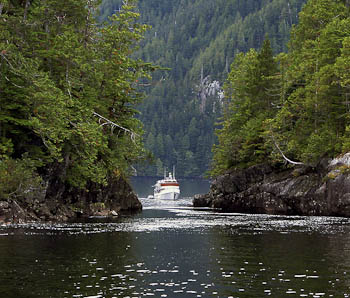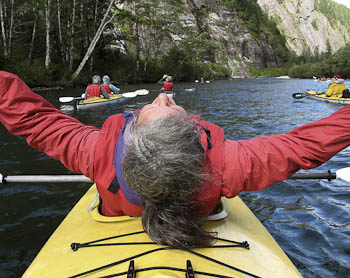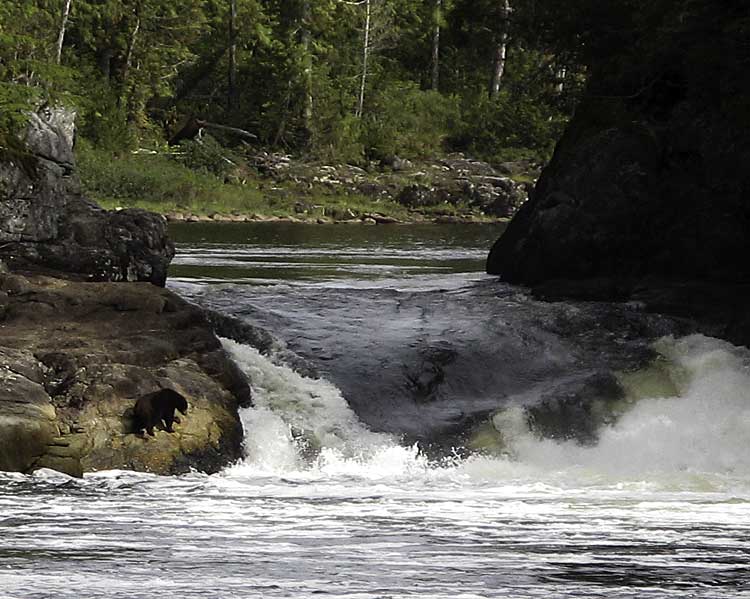SPIRITS OF THE WATER:
A VOYAGE TO BRITISH COLUMBIA’S GREAT BEAR RAINFOREST
September 7-18, 2010
12 Days/11 Nights
Audrey Benedict, Marven Robinson, Kimber Owen & the M/V Sea Wolf Crew
A voyage to the wild archipelagos of coastal British Columbia allows us an unparalleled window into an ancient, more magical world— one in which all life is inextricably linked to the sea.  Joining the M/V Sea Wolf at Ketchikan, Alaska, we leave the standard cruise routes behind as we embark on a voyage along a coast so convoluted with glacier-carved fjords, channels, inlets, and islands, that a distance measurement of the actual coastline is virtually impossible. Life here is governed by the sea’s rhythms and we turn our attention to navigating a watery maze of channels, passes, and reaches. Strange, reversing tidal rapids—like sea-bound rivers—impress us with their power and purpose. The rock-bound intertidal zone is home to an amazing diversity of marine animals: crabs, starfish, anemones, sea urchins, and sea cucumbers, to name just a few. The seabirds and shorebirds we see, among the thousands beginning their long migrations to southern waters, live at the mercy of wind and wave—as the sea goes, storm-ridden or serene, so must they. Their survival, as we will learn, is undeniably tied to the ecological health of the sea as well as to that of the terrestrial ecosystems ashore—making them especially vulnerable to the impacts of global warming, marine pollution, diminished food resources, commercial fishing, seabird by-catch, fish farming, logging, mining, and changes in the rich plankton soup that forms the basis for the entire marine food chain. Joining the M/V Sea Wolf at Ketchikan, Alaska, we leave the standard cruise routes behind as we embark on a voyage along a coast so convoluted with glacier-carved fjords, channels, inlets, and islands, that a distance measurement of the actual coastline is virtually impossible. Life here is governed by the sea’s rhythms and we turn our attention to navigating a watery maze of channels, passes, and reaches. Strange, reversing tidal rapids—like sea-bound rivers—impress us with their power and purpose. The rock-bound intertidal zone is home to an amazing diversity of marine animals: crabs, starfish, anemones, sea urchins, and sea cucumbers, to name just a few. The seabirds and shorebirds we see, among the thousands beginning their long migrations to southern waters, live at the mercy of wind and wave—as the sea goes, storm-ridden or serene, so must they. Their survival, as we will learn, is undeniably tied to the ecological health of the sea as well as to that of the terrestrial ecosystems ashore—making them especially vulnerable to the impacts of global warming, marine pollution, diminished food resources, commercial fishing, seabird by-catch, fish farming, logging, mining, and changes in the rich plankton soup that forms the basis for the entire marine food chain.
View Larger Map
Along the central coast, we enter a mist-shrouded wilderness set amidst a backdrop of sheer cliffs and steep-walled fjords, plunging waterfalls, old-growth rainforests, and glacier-carved mountains. We’ll enjoy myriad opportunities to explore—a magical world that can be reached only by boat or sea kayak. The rainforests are home to some of the world’s most majestic trees—Douglas fir, Sitka spruce, red cedar, and western hem-lock—with some towering over 300 feet in height, trunks measuring 19 feet in diameter, and some at least 1,000 years old.  The shaded streams and rivers that wind through these forests offer the perfect clear, cold spawning grounds for six species of salmon that return here each year: coho, chinook, sockeye, pink, chum, and steelhead. Where the salmon-spawning rivers empty into the inlets and estuaries, the jade-green waters carry the haunting scent of ghost salmon returning to the sea. These salmon runs—the literal and metaphorical heart of this ancient forest ecosystem—provide an almost continuous supply of food during late summer and fall, particularly for bears preparing for hibernation, but also for coastal gray wolves, bald eagles, gulls, dippers, pine marten, river otters, mink, and many others. Research by Ian McAllister, Chris Darimont, Paul Paquet, Tom Reimchen, and others have shown that salmon actually sustain the entire Great Bear Rainforest ecosystem.The bears—one of the highest concentrations of grizzly bears found in North America, black bears, and the legendary “Spirit Bear,” a rare, white-blonde subspecies of the black bear—are crucial to the transfer of marine-derived nutrients (from decomposing salmon) into both freshwater and terrestrial ecosystems ashore. Trace nutrients from salmon are found in the topmost needles and wood of the forest’s trees. Recent research has also shown that large individual growth rings in the wood of these trees can be correlated with heavy salmon runs. The shaded streams and rivers that wind through these forests offer the perfect clear, cold spawning grounds for six species of salmon that return here each year: coho, chinook, sockeye, pink, chum, and steelhead. Where the salmon-spawning rivers empty into the inlets and estuaries, the jade-green waters carry the haunting scent of ghost salmon returning to the sea. These salmon runs—the literal and metaphorical heart of this ancient forest ecosystem—provide an almost continuous supply of food during late summer and fall, particularly for bears preparing for hibernation, but also for coastal gray wolves, bald eagles, gulls, dippers, pine marten, river otters, mink, and many others. Research by Ian McAllister, Chris Darimont, Paul Paquet, Tom Reimchen, and others have shown that salmon actually sustain the entire Great Bear Rainforest ecosystem.The bears—one of the highest concentrations of grizzly bears found in North America, black bears, and the legendary “Spirit Bear,” a rare, white-blonde subspecies of the black bear—are crucial to the transfer of marine-derived nutrients (from decomposing salmon) into both freshwater and terrestrial ecosystems ashore. Trace nutrients from salmon are found in the topmost needles and wood of the forest’s trees. Recent research has also shown that large individual growth rings in the wood of these trees can be correlated with heavy salmon runs.
 The Great Bear Rainforest is the traditional homeland of the indigenous Heiltsuk, one of several First Nation cultural groups whose history, identity, and spirituality are inextricably intertwined with that of the sea and the coastal forests. With our Gitga’at guide, Marven Robinson, we’ll spend the day on a viewing platform positioned above a stream heavily used by bears during the salmon spawning period. Opportunities for observing and photographing “fishing” bears, including the spirit bear, are excellent, as are our chances of seeing other species that specialize on salmon “leftovers.” A Gitga’at community-sponsored dinner of traditional foods and dances performed in their communal longhouse will highlight our day spent with the bears. Our spirits nourished by wonderful memories and shared experiences, the conclusion of our voyage, at Bella Bella, comes all too soon! The Great Bear Rainforest is the traditional homeland of the indigenous Heiltsuk, one of several First Nation cultural groups whose history, identity, and spirituality are inextricably intertwined with that of the sea and the coastal forests. With our Gitga’at guide, Marven Robinson, we’ll spend the day on a viewing platform positioned above a stream heavily used by bears during the salmon spawning period. Opportunities for observing and photographing “fishing” bears, including the spirit bear, are excellent, as are our chances of seeing other species that specialize on salmon “leftovers.” A Gitga’at community-sponsored dinner of traditional foods and dances performed in their communal longhouse will highlight our day spent with the bears. Our spirits nourished by wonderful memories and shared experiences, the conclusion of our voyage, at Bella Bella, comes all too soon!
Price: $4,950 (includes a $500 deposit)
Group Size: 12
Trip Rating: 2 (Accessible)
Price Includes: 10 nights and 11 days aboard the M/V SeaWolf, all meals, cabins with private facilities, one nights’ lodging at the Cape Fox Lodge in Ketchikan, the services of a 5-person crew, 3 naturalist leaders, full sea kayak outfitting and instruction, guide services by Marven Robinson, Gitga’at community dinner and performance, gratuities to the crew, and all hotel/boat transfers.
Does not include roundtrip airfare from your point of departure to Ketchikan, Alaska, the flight segment (prearranged) from Bella Bella to Vancouver, B.C., or your homebound flight from Vancouver.

|
